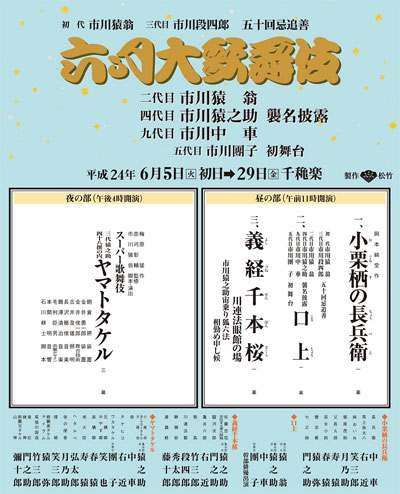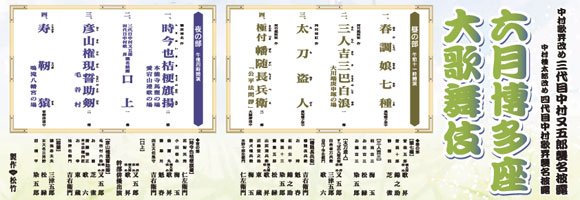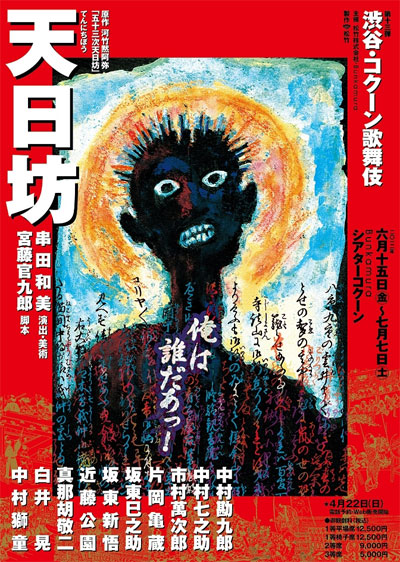| JUNE 2012 |
|
4 shows in T˘ky˘ (Shinbashi Enbuj˘, National Theatre, Theatre Cocoon), 2 in Nagoya (Misonoza), 1 in Ky˘to (Minamiza) and 2 in Fukuoka (Hakataza)!
|
| Shinbashi Enbuj˘ (T˘ky˘) |
| Dates | 5 ~ 29 June 2012 (Rokugatsu ďkabuki) June Grand Kabuki |
| MatinÚe | |
| Evening | |
| Casting |
Ichikawa Ennosuke, Ichikawa En'˘, Sakata T˘jűr˘, Ichikawa Danshir˘, Kataoka Hidetar˘, Band˘ Takesabur˘, Band˘ Yajűr˘, Ichikawa Chűsha, Ichikawa Danko, Ichikawa Monnosuke, Ichikawa Ukon, Ichikawa Tsukinosuke, Ichikawa Emisabur˘, Ichikawa Emiya, Ichikawa Shun'en, Ichikawa En'ya, Ichikawa Juen, Ichikawa K˘tar˘ |
| Comments |
2 shűmei and 2 hatsubutai for 3 generations of Omodakaya actors! This month at the Shinbashi Enbuj˘, the Omodakaya guild commemorates the 49th anniversary (50th memorial service) of late Ichikawa En'˘ I and Ichikawa Danshir˘ III. Ichikawa Ennosuke III and his nephew Ichikawa Kamejir˘ II take the names of Ichikawa En'˘ II and Ichikawa Ennosuke IV. Ichikawa Ennosuke III's son Kagawa Teruyuki, a movie star in Japan, and Ichikawa Ennosuke III's grandson Kagawa Masaaki make their debut on stage (hatsubutai); they respectively receive the names of Ichikawa Chűsha IX and Ichikawa Danko V.
|
 |
|
|||
| Dates | 2 ~ 26 June 2012 (Rokugatsu ďkabuki) June Grand Kabuki |
||
| MatinÚe |
Haru no Shirabe Musume Nanakusa |
||
| Evening |
Toki-ha Ima Kiky˘ no Hataage (Badarai) |
||
| Casting |
Kataoka Nizaemon, Nakamura Kichiemon, Band˘ Mitsugor˘, Nakamura Matagor˘, Nakamura Kash˘, Nakamura Baigyoku, Nakamura Shibajaku, Nakamura Kaishun, Nakamura Kinnosuke, Nakamura Karoku, Nakamura T˘z˘, Ichikawa Somegor˘, Onoe Sh˘roku, ďtani Tomoemon, Nakamura Matsue, ďtani Keiz˘, Band˘ Kametoshi, Nakamura Tanenosuke, Nakamura Yonekichi, Nakamura Umemaru, Nakamura Hayato |
||
| Comments |
Nakamura Matagor˘ III and his son Nakamura Kash˘ IV celebrate their shűmei in Fukuoka at the Hakataza!
|
||
 |
|
|||
| Dates | 15 June ~ 7 July 2012 | ||
| Program |
Tennichib˘ |
||
| Casting | |||
| Comments |
13th edition of the original Cocoon Kabuki performance, which recreates the atmosphere of the Edo koshibai and brings the actors closer to the audience.
|
||
 |
| Misonoza (Nagoya) |  |
| Dates | 3 ~ 26 February 2012 (Rokugatsu ďkabuki) June Grand Kabuki |
| MatinÚe |
|
| Evening |
Ishikawa Goemon |
| Casting |
Ichikawa Danjűr˘, Ichikawa Ebiz˘, Kataoka Takatar˘, Ichikawa Sadanji, Kataoka Ichiz˘, Ichimura Kakitsu, Ichikawa Omez˘, Band˘ Kamesabur˘, Nakamura Baishi, Nakamura Mantar˘ |
| Comments |
|
|
|||
| Dates | 2 ~ 24 June 2012 (Band˘ Tamasabur˘ Tokubetsu K˘en) Band˘ Tamasabur˘ Special Performances |
||
| Program |
Dan no Ura Kabuto Gunki (Akoya) |
||
| Casting | |||
| Comments |
This special program celebrates the 1050th anniversary of the foundation of the Rokuharamitsuji temple in Ky˘to [more details in Japanese].
|
||
| National Theatre (T˘ky˘) |
| Dates | 2 ~ 24 June 2012 (Rokugatsu Kabuki Kansh˘ Ky˘shitsu) |
| Program | |
| Casting |
Nakamura Hashinosuke, Ichikawa Danz˘, Kawarasaki Gonjűr˘, Nakamura Kotar˘, Nakamura Shinobu, Nakamura Shikimatsu |
| Comments |
Educational program at the National Theatre called Kabuki Kansh˘ Ky˘shitu ('Kabuki Appreciation Class'). This is a very interesting formula for the beginners because there is lively presentation on stage of Kabuki or some aspects of the art like music, stage tricks or fighting scenes, followed by the drama "Shunkan".
|
|
|
| Contact | Main | Top | Updates | Actors | Plays | Playwrights | Programs | Links | FAQ | Glossary | Chronology | Illustrations | Prints | Characters | Derivatives | Theaters | Coming soon | News |

